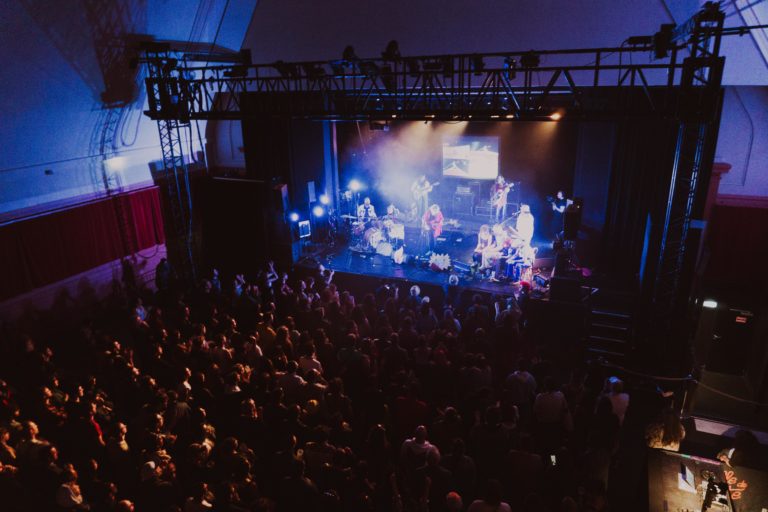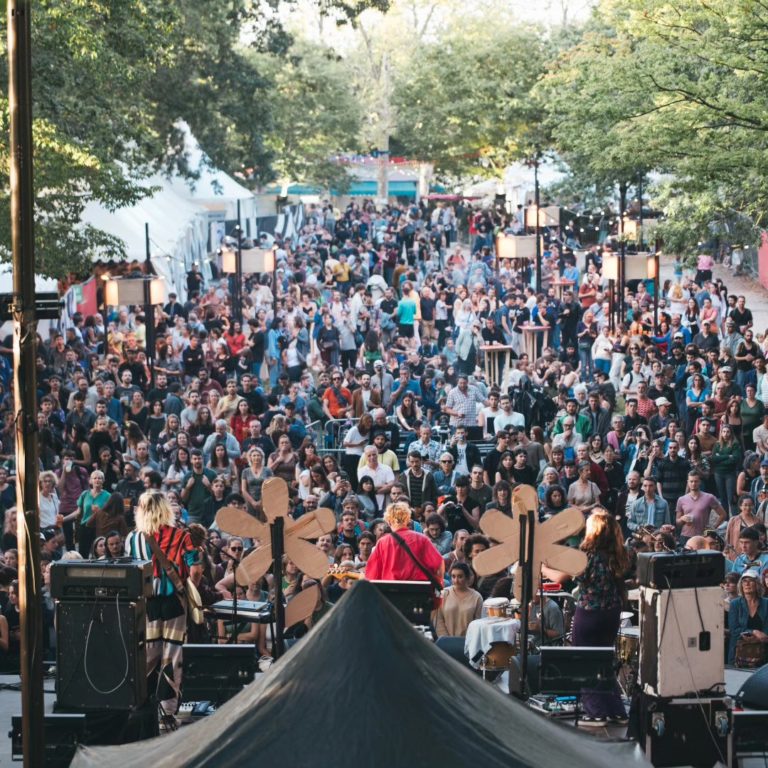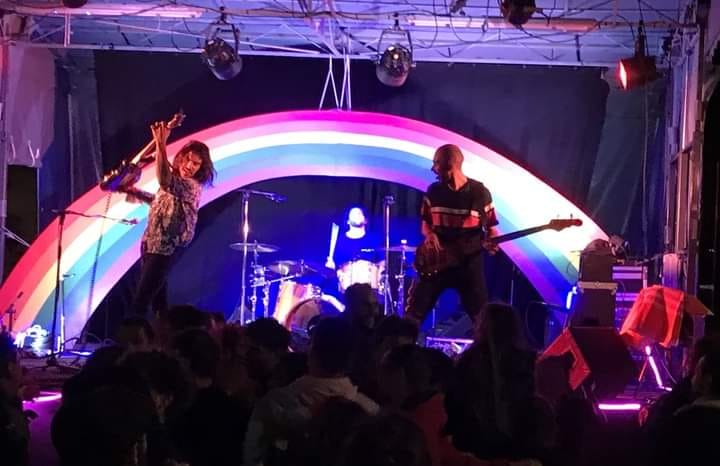Author: Salomé Duhoo
Fighting climate change is certainly our century’s biggest challenge, and addressing it needs to rally society as a whole. Being intrinsically entrenched in their era’s political concerns, it is understandable that the arts have ceased this topic. Still, it is not only a matter of addressing this challenge in the arts’ content, but also its practices. When it comes to carbon emissions, the arts are like every other line of business: creating and broadcasting artistic projects generates emissions, which add to every other aspect and have a long-term harmful impact on global warming.

Emerging band Bou (@bou.est.ton.ami) at the Salle de la Cité, Rennes – © Marine Vergnes
Performing arts are affected by this matter, because the logistics they require, both during creation and exploitation phases, can have a huge environmental impact; especially when it comes to transportation. It is particularly significant for music festivals because of their multi-artists programming, which mechanically increases the number of artists trips necessary. Also, live music is the field whose economic weight, and thus ecological impact, is one of the biggest in the European cultural and creative industries. Last but not least, live music is the easiest form of performing arts to tour on a large scale, since there is a lesser language barrier, compared for instance to theatre, allowing the issue of large-scale travel to arise more often.
It is crucial for their sustainability that the creative and cultural industries reflect on a path to reduce their carbon footprint. Despite their economic weight and due to their incidental-to-survival nature, they tend to be perceived as dispensable and, in the event of a crisis, be it geopolitical (a war) or ecological (which is pending and the topic of this article), they will be the first to be suspended. Thus, it is crucial for their own survival that they play a proactive role in driving energy sobriety. When it comes to music festivals, making emerging artists a key to their programming strategy could have a deep lever effect. The French music festival industry, with its flourishing scene, provides an interesting framework for reflecting on this idea. France’s institutional history of financial support for the arts (even though increasingly under threat) also makes it possible to reflect on the quantity and quality of public funding from the perspective of emerging talent and the sustainable development of the performing arts at European level.
Assessing Carbon Impact in Music Festivals
The French live music industry has undeniably ceased the matter of sustainable development and ecological transition. Many high-stakes, national institutional actors (for instance the Ministry of Culture’s National Centre for Music) are promoting and funding a shift on this particular matter. At the same time, independent actors are also reflecting on their own carbon emissions through various initiatives and researches. The Cabaret Vert Festival, in Charleville-Mézières (France), has published as part of its Decarb-ON initiative a carbon balance audit. This report shows that transportation accounts for 55% of the festival’s carbon footprint. That being stated, it appears that transportation is the most efficient lever to pull to improve a festival’s carbon balance. There are three axes alongside which festivals can improve their carbon footprint regarding transportation: audience transportation, service providers transportation (deliveries, equipment logistics, etc.), and artists transportation.
Several French music festivals have worked on the aspect of attendance’s footprint through transportation, notably by promoting train access to the festival’s facilities. Some even took a few more steps by cooperating with national railway services on logistics and packages: for instance, the Jazz à Vienne (Vienne, Isère) and Mythos (Rennes, Brittany) offer a package including a concert’s ticket and a discounted train ticket, in partnership with regional railway institutions. When it comes to service providers, the best way to reduce a festival’s carbon footprint is to hire local service providers (for instance, caterers) in order to reduce the carbon footprint of goods consumed on the grounds of the festival. Still, there is one other way to improve festivals’ carbon balance, often overlooked: artists’ transportation. One could argue that it is touchy, when it comes to the creative sector, to curb the artistic dimension for the sake of energetic sobriety. Yet here is a stake in both the creative vitality and sustainability of artistic practice: emerging artists.

Breton band Bou (@bou.est.tom.ami) at the I'm from Rennes festival – © Marine Vergnes
The link between emerging artists and climate change may not be obvious at first sight, but emphasising emerging, by definition more local artists, could hugely influence a music festival’s environmental impact. Indeed, when a music festival books an artist or a group, transport must be organised not only for the artistic team, but also for their technical crew, decors, costumes, equipment, etc. This impacts their carbon footprint in several ways: most obviously, the shorter the distance, the more moderate the carbon emissions. Distance also plays a role on which type of transportation is available. The train is known to be the most environment-friendly transportation. However, it can be difficult for artists to travel with their entire team and equipment if, for example, the train route forces them to change stations, leading some to rather travel by van, which is much more carbon-emissive. On an even larger scale, if European music festivals choose to book American artists, for instance, the only sensible way to get them to the venue is by plane, which is notoriously high in carbon emissions.
Still, emerging artists are more of a financial liability for promoters as their ticket selling potential is inferior to that of more established headliners. Taking this parameter into account, how can we make such an artistic risk financially sustainable? Of course, it should not be the organisers’ sole responsibility to answer this question, but rather of the entire cultural ecosystem.
Emerging Artists and Financial Equilibrium
A festival has to reach for at least financial equilibrium in order to be sustainable on the mid- and long-term. In that perspective, betting on emerging artists raises the following questions: in that context, how to retain an audience? How should decision-makers and institutional funders support such a strategy?
For music festivals organisers, a famous headliner is perceived as a guarantee in terms of ticket-selling. Still, reality does not necessarily condone this. When we look into 2023 programming, we see that Disiz performed in 20 different festivals, whereas Angèle and Lomepal performed in 17, some of them being geographically close. Then, counting on festival-goers that come just for one big-named headliner is a liability, if several festivals offer the same line-up. Festivals should actually consider the bigger picture, taking into account that music festivals are both a place of artistic consumption, but also sociability. To attract the public, festivals can also choose to offer a full experience to their audience. For instance, the Art Rock Festival (Saint-Brieuc) takes over the whole city, which highlights the “hospitality” side of the event. Curating a festival alongside a certain artistic commitment is actually easier when it includes emerging artists, since their fee is usually low(er) and there are more of them. Then, a festival’s expertise on a certain genre or aesthetic will allow it to stand out in an abundant cultural scene, rather than relying on big names alone. Even emerging artists can be a curating parti pris: the Transmusicales festival is a cultural institution since 1979 in the city of Rennes, and their expertise is known for artists and bands who are still mostly confidential. They featured emerging Nirvana, Lenny Kravitz or, more recently, Justice. The Transmusicales’ audience attends for the expertise and the experience, not the famous names.

Breton-speaking rock band Ebel Elektrik at the Paimpol in Rock festival – © Pierre Morvan
On the other hand, it also appears that many French music festivals struggle to reach financial equilibrium. The SMA (Union for Modern Music) highlights that 43% of its adhering festivals ended their 2023 edition with a budgetary deficit. Concomitantly, 45% of those same members did not manage to sell tickets out on at least one day of their event. This indicator underlines that many music festivals maybe need to downsize to avoid bankruptcy. In France, in a certain way, economic limits have already enforced a certain energetic sobriety: because the cost of labour is higher than for instance in Italy, production costs in general are higher and festivals favour French artists to control costs. Emerging artists fit into this frame and can take this process a step further for small and medium-sized music festivals. Still, this logic does not limit to Western-European countries. Indeed, lavish, energy intensive music festivals held in cost-effective countries (for instance the Ultra Europe festival in Croatia) do not target a local audience, but rather a rich Western-European audience. Resorting to emerging artists will help produce events that benefit local communities, cultural diversity, and will improve the audience’s carbon footprint in the process.
It seems that exploring a shift in the artistic direction of music festivals by making their line-ups more innovative is often overlooked in their reflections on ecological transition, presumably for fear of compromising the artistic quality of these events. Nevertheless, every lever to decrease carbon emissions should be explored as the climate crisis becomes more urgent every year. It is foolish to think that music festivals should carry on with business as usual in the face of this crisis. In 2022, climate events in the form of bad weather have disrupted several music festivals in France, and this is likely to happen frequently now. In order for the transition to energy sustainability to be as democratic and free as possible, every actor needs to be involved as soon and straightforwardly as possible.
Published on September 3rd, 2024
About the author:
Headquartered in Rennes, Brittany, Salomé Duhoo is the head of Sieben Kulture. She is an administrator, specialised in live music and performing arts. She advises theaters, artistic companies, festivals, and cultural venues on financial and legal management, as well as CSR policies (equality, inclusion, sustainability, etc.) in cultural events.